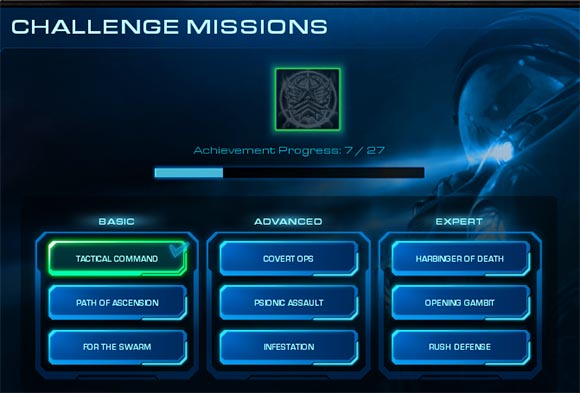Initially, multi-player was without form, and void. People would randomly engage with each other in endless, monotonous Quake 3 matches. Then came Call of Duty 4. It introduced simple RPG elements into multi-player. Players would collect experience points, unlock achievements and upgrades. They would maintain a profile across matches. It provided a rudimentary structure to multi-player. Players saw that it was good. Designers started to blindly copy this approach, with not always the best results.
One of the reasons why I really enjoy Star Craft II is that it goes further. It creates a much more comprehensive structure to multi-player. It especially focuses on guiding new players into the multi-player community in ways it has not been done before. The game has a group of achievements called “Exploration”. They are specifically designed to teach players the necessary skills to compete on-line.
There are 3 levels of Exploration achievements. They start out with tasks like playing a certain number of games against the AI. They end up with tasks like playing and winning certain kinds of multi-player modes against other human opponents. But that’s not all. A key element of the Exploration achievements are the Challenge Missions.
The single-player mode a the multi-player mode drifted apart even further in Star Craft II. Single-player now includes units and upgrades that don’t exist in multi-player. Transferring skill from one mode to another is even more difficult. The Challenge Missions are here to fill the gap.
They are single-player missions specifically designed to teach multi-player skills. For example, the early missions will make you defend yourself against waves of various type of units. You have a limited amount of certain units yourself. Your task is to split your army and perfectly match your units against the enemy. Think of it as tower defense but with units instead of towers. Other Challenge Missions teach you how to build up your economy or counter a rush.
It’s a very polished, user-friendly and fun way to ease players into the multi-player way of thinking. The challenges are perfectly balanced so that there is aways a key insight to solve the puzzle – something that might not happen in real multi-player. The game even provides you with hints in case you can’t figure it out yourself. And when you eventually make it, there is still plenty of things to learn by micro-managing your battles to maximize efficiency in order to score a better ranking.
But of course, not everything is quite perfect yet. The Exploration Achievements are hidden among a flood of various other achievements. It seems to me that it is very likely that new players will miss them altogether. The Challenge Missions also also a bit under-played and seem to be a little limited in scope.
More generally, the game provides a structure on how to get INTO multi-player but doesn’t provide a structure of how to get OUT of multi-player. There are no exit points that would provide closure for players, who don’t want to keep playing forever. Under this circumstances there are two possibilities – you either become an eSports pro gamer or you quit the multi-player out of boredom and frustration. Considering how the percentage of pro gamers is rather small, a vast majority might end up looking back on Star Craft II not quite favorably. I guess that innovation in multi-player structure is still to come.
Nevertheless, I’m still quite impressed by the improvements. I really do hope other games will copy this approach. I would love to see Challenge Missions for other types of games. I wonder what a Challenge Mission for a first-person shooter would look like.







